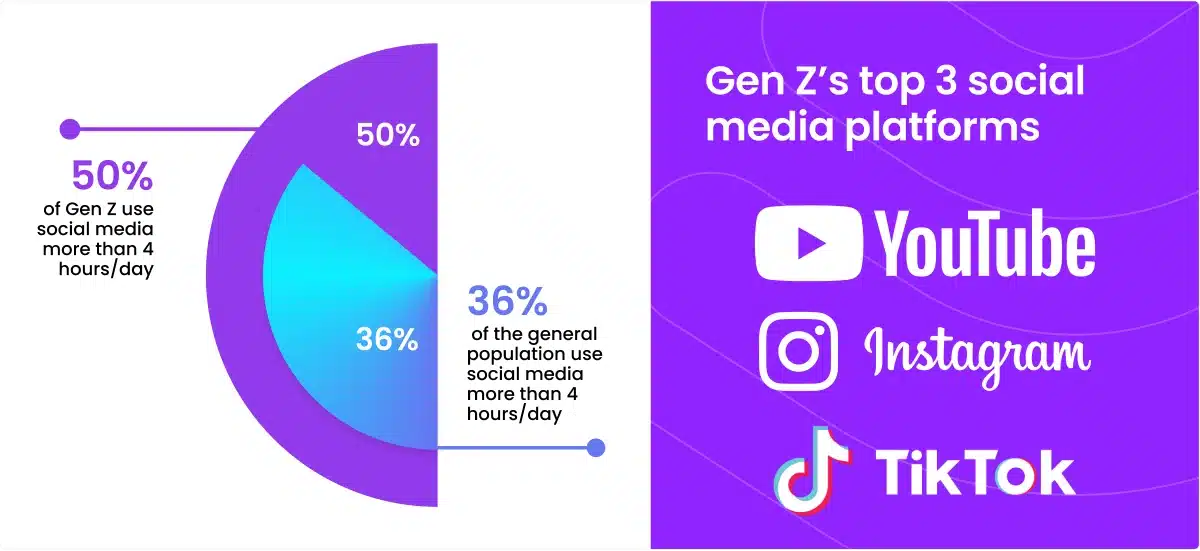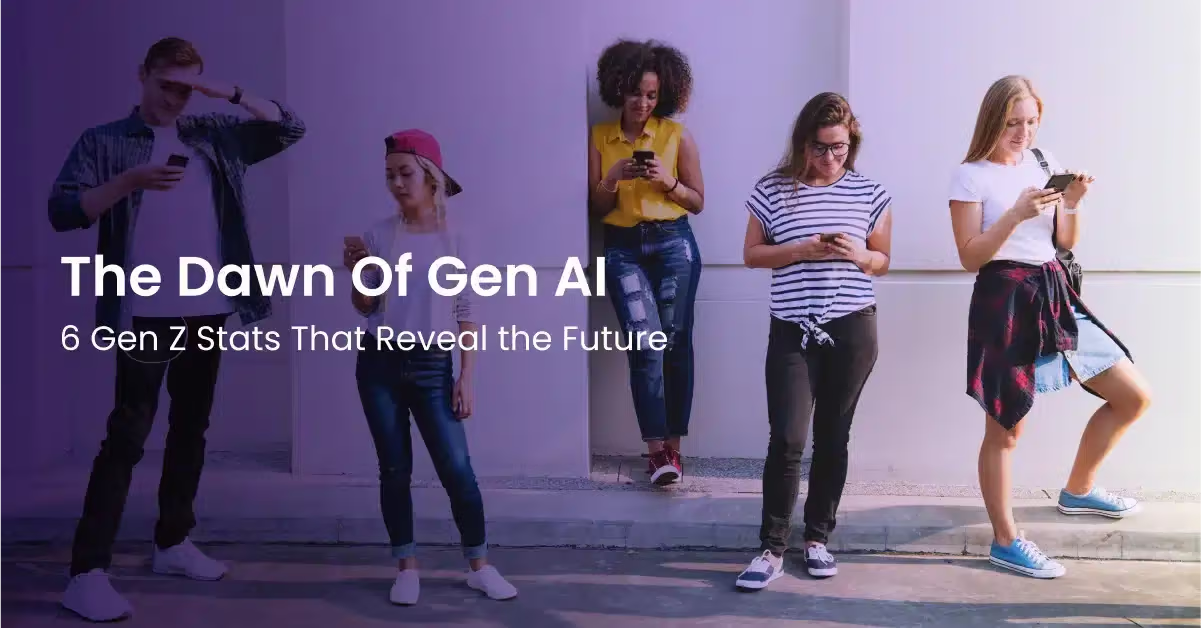


Generational trends and patterns are one of the most powerful ways to understand audience behavior. Understanding these patterns is essential to forecasting the evolution of Generation Z and connecting effectively with them.
Generational trends tend to rotate every 20 to 30 years. That’s why the 1980s nostalgia wave hit in the 2010s with “Stranger Things,” “Rocket Man” and “Straight Outta Compton.” The revival of 1990s and 2000s trends are quickly become significant as well.
These repeating cycles tell an important story about generational change. At the same time, it’s important to keep an eye on what makes Gen Z (born 1997-2012) – distinct as social natives.
We’ll also reveal the key technology that will shape Gen Alpha (born in 2012) when they reach early adulthood by the end of this decade.
6 Gen Z Stats: How Gen Z Uses Media and Tech
When we talk about generations, it’s important to start with data. The following data points reveal just how different Gen Z is from other parts of the population.
1. Gen Z Is A Large Part of The Population
Meeting Gen Z expectations is crucial for two reasons. First, Gen Z is large: 20.88% of the US population as of 2022, which is slightly larger than Boomers (20.58%). Second, Gen Z is the future. Earning Gen Z engagement and loyalty today will pay dividends for decades.

2. The Most Connected Generation
With Gen Z’s passion for connectivity, it’s not a surprise that they have higher rates of digital device ownership than the rest of the population.
94% of Gen Z own a laptop, far higher than the 80% ownership for the rest of the population.
In North America, 96% of Gen Z own a smartphone, according to a 2017 survey, vs 98% in Europe. Further, most Gen Z consumers say their smartphone is their most crucial connected device.
3. Smartphone As A Second Screen

81% of Gen Z uses their smartphone as a second screen, compared to just 55% for everyone else. New to the second screen concept? Find out more in our post: What are second-screen experiences?
4. Significant Daily Social Media Usage

50% of Gen Z use social media more than 4 hours / day vs 36% of the general population. Gen Z’s top 3 social media platforms are YouTube, Instagram, and TikTok. Image and video-oriented social media content tend to draw the largest Gen Z audiences. For this reason, Gen Z is often described as social natives.
5. Screen Time Per Day Favoring User-Generated Content
Gen Z spends 7.2 hours per day watching video vs. 6.3 hours per day for Gen X, according to the LA Times. It’s not just the quantity of screen time that makes Gen Z different. The Times found that 48% of Gen Z spend their viewing time watching content creators on TikTik and YouTube rather than traditional media.
6. Gen Z Is Watching Less Traditional TV Than Other Generations
Nearly one-third of Gen Z (30.8%) adults spend 3-5 hours of time on social media per day (source). In contrast, the average Gen Zer only spends a little over 1 hour per day (1:08) watching television. The decline in TV viewing is essential when you compare the 18-24 group to the 55-64 demographic, who watches over 3 hours of TV per day.
As social natives who are online for hours every day, it’s no surprise that Gen Z has many early tech adopters. That is a key reason why Gen Z is positioned to become Gen AI.
The Next Big Gen Z Online Trend
The launch of Chat-GPT in November 2022 came at the perfect moment for Gen Z. The prior generation of AI tools was highly technical and mainly limited to a small user base of advanced users. Furthermore, older AI technologies emphasized decision trees and relatively simple pattern matching.
Chat-GPT and other generative AI technologies differ from earlier AI technologies in two crucial respects. First, generative AI usually offers a highly user-friendly interface. If a user knows how to chat online and use social media, generative AI will feel easy. Second, generative AI has some general-purpose capabilities like producing essays, blog posts, and even attempting to pass standardized tests.
Arena AI Concierge for Publishers, Content & Affiliate Commerce is here. Request early access.
The Dawn of Gen AI
In 2022 – the year Chat GPT launched – Gen Z ranged in age from 10 to 25. That means that the oldest members of the generation are joining the workforce, and mainly more are moving into college.
They’re positioned to see the value of generative AI tools and integrate them into their workflows. By the time the majority of Gen Z graduates, generative AI tools will become standard. Early AI adopters are already using AI at work. Forty-two percent of Gen Z – the highest of any age cohort – were afraid to tell their managers they are using AI at work, according to a 2023 survey vs one-third of the general workforce.
In about 10-15 years, Gen Z’s success with AI will fade into memory because of the rise of Gen Alpha (born starting in 2012). Just as Gen Z never knew a world without social media, the oldest members of Gen Alpha were just 10 years old when user friendly generative AI became widely available.
The transformative effects of generative AI in education and business will start to grow in the 2020s. By the 2030s – when Gen Alpha or “Gen AI” – comes of age, AI will open up a whole new wave of technology, new forms of business, and ways of learning.
Recent digital history offers reasons to be hopeful about the future. In the 1990s and 2000s, MP3 peer-to-peer file sharing boomed thanks to apps like Napster. For a time, many in the music industry attempted to stop the innovation through lawsuits and other means.
However, the experience of accessing large amounts of music in digital format ultimately sets the stage for today’s streaming companies. By 2022, the digital music streaming industry was worth over $13 billion. To put that revenue figure in perspective, CD sales revenue peaked at $13 billion in 2000 and fell to a mere $584 million by 2021.
Generation Z is positioned to adopt AI tools into their work, leisure, and online experiences. They will have more experience – and potentially enthusiasm – for AI technologies than any other generation.
The key to keeping Gen Z (or Gen AI) engaged with your brand lies in adopting AI throughout your organization. Resisting AI – while popular today – is unlikely to pay off in the long term as this technology continues to grow.



